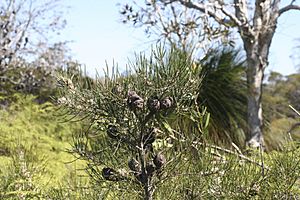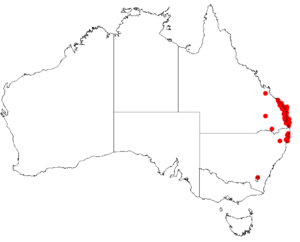Mulloway needle bush facts for kids
Quick facts for kids Mulloway needle bush |
|
|---|---|
 |
|
| Scientific classification | |
| Genus: |
Hakea
|
| Species: |
actites
|
 |
|
| Occurrence data from the Australasian Virtual Herbarium | |
Hakea actites, also known as the mulloway needle bush or wallum hakea, is a cool shrub or small tree. It belongs to the Proteaceae family, which has many unique plants. You can find this plant growing in parts of north-eastern New South Wales and south-eastern Queensland, Australia. It's known for its pretty white flowers that are full of nectar, appearing from late autumn to early spring.
Contents
What Does the Mulloway Needle Bush Look Like?
The Hakea actites is a prickly shrub or small tree that can grow from 0.3 metres (1.0 ft) (about 1 foot) up to 5 metres (16.4 ft) (about 16 feet) tall. It has a special woody swelling at its base called a lignotuber. This helps the plant regrow after fires.
Its smaller branches are covered with soft, matted hairs. The leaves are light green and look like needles. They are 3.5 to 13.5 centimetres (1.4 to 5.3 in) (about 1.4 to 5.3 inches) long and very thin, only 0.3 to 1.3 millimetres (0.0 to 0.1 in) (less than an inch) wide. Each leaf ends with a sharp point.
The plant produces 1 to 6 white flowers in small groups. These flower clusters grow where the leaves meet the stem. The flowers have short stalks covered in tiny, rusty-colored hairs. The main part of the flower, called the Perianth, is 3.1 to 4.3 millimetres (0.1 to 0.2 in) (about 0.12 to 0.17 inches) long, white, and smooth. Sometimes, it might have a bluish-green color with a powdery look.
After flowering, the plant produces wrinkled, egg-shaped fruits. These fruits are 20 to 35 millimetres (0.8 to 1.4 in) (about 0.8 to 1.4 inches) long and 16 to 25 millimetres (0.6 to 1.0 in) (about 0.6 to 1 inch) wide. They have a smooth, rounded beak and small, unclear "horns." Sometimes, the fruits might have rough, blister-like bumps. This plant flowers from May to September.
The mulloway needle bush looks a lot like another plant called the Hakea sericea.
How Scientists Named This Plant
The scientific name Hakea actites was first officially described by a botanist named William Barker in 1996. This description was published in a science journal called the Journal of the Adelaide Botanic Garden. The first plant specimen used for this description was found near Angourie, New South Wales in Australia.
The second part of the name, actites, comes from an Ancient Greek word. It means "shore dweller." This name makes sense because the mulloway needle bush is often found in coastal areas.
Hakea actites is part of a group of Hakea plants called the Sericea group. Most of these plants grow in eastern Australia. They all have simple, needle-like leaves, only a few flowers in each cluster, hairy flower stalks, and single woody fruits. Other plants in this group include Hakea constablei, Hakea decurrens, Hakea gibbosa, Hakea lissosperma, Hakea macraeana, Hakea sericea, and Hakea tephrosperma.
Where Does It Grow?
You can find Hakea actites in swampy places along the coast. Its range stretches from around Hervey Bay in south-eastern Queensland down to just north of Coffs Harbour in New South Wales.
This plant grows well in damp, sandy soils or sandy clay. It is often found in open wallum heathland areas. These are special types of shrublands. It also grows in forests where Eucalyptus trees are common.
Why Is This Plant Special?
The mulloway needle bush is a very tough and hardy plant. You can grow it from its seeds. It's especially good for coastal areas that are a bit swampy.
Because it's prickly and produces so many flowers, it's great for nature! It offers protection and nesting spots for small birds. The abundant nectar in its flowers also provides a good food source for them.

